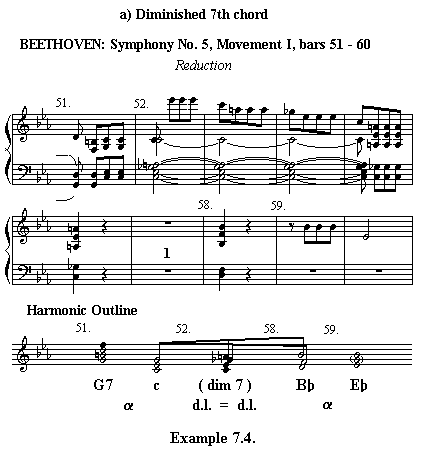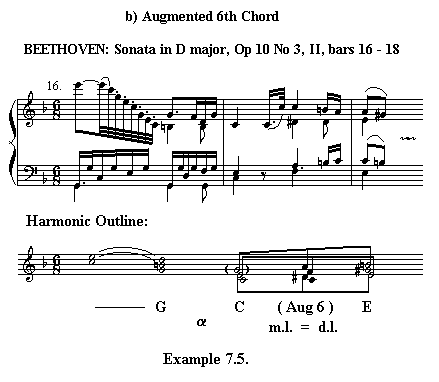
CHAPTER 7 (PART 2)
MODULATION
Modulation via Chromatic Chords
German 6th
chords can be created on all chromatic and diatonic notes within the scale.
As these are the same, enharmonically, as dominant seventh chords, they
can be reinterpretation as dominant 7th chords in all keys. However, this
is really just a form of "direct to dominant" modulation. A
more common method of modulation is for a chromatic
chord to move onto the new dominant rather than becoming the dominant
itself. The diminished
7th and augmented
6th chords are the chords most commonly used for this purpose.
These progressions normally take place within an episode of dynamic
harmony. The movement to a new key is thus made by the use of a musical
'pun'. The chord progressions used can be summarised in the following
table:

The chromatic chord is moved to as a passing chord from the tonic of the old key and is immediately reinterpreted as dominant leading in the new key. It then moves on as a passing chord to the new dominant chord with or without an intervening cadential 6 4 appoggiatura chord. The diminished seventh chord and augmented 6th chords are the most useful and common ways of making this type of modulation. They act as chromatic pivot chords. Here, the composer is using a 'trick of the trade' by reinterpreting the meaning of a chromatic chord. Consequently, the normal strong root progression between functional chords is broken and the two functional chords may be related by a weak chord progression. The composer is using a consciously learned process which is overriding the normal subconscious use of strong chord progressions. These progressions are normally used, nevertheless as part of a dynamic harmony episode.
Following are two examples:

In this example, bar 51 ends in C minor. The C minor chord is immediately followed by a passing diminished 7th chord which is dominant leading in C minor. This is reinterpreted as dominant leading in the new key of E-flat major. The diminished 7th chord is followed by the B-flat dominant chord of E-flat. This brief dynamic harmony acts as link passage from the first subject in C minor to the second subject in E-flat. The progression from the C minor chord to the B-flat chord would normally be too weak a progression to use in dynamic harmony but the modulation makes the chord progression acceptable. The modulation and harmony support the background syntactic structure.

In this example, the closing section of the phrase has arrived at a perfect cadence in C major. The C major chord moves onto the augmented 6th chord by linear movement. This is immediately reinterpreted as a dominant leading chord in the new key of A minor. The augmented 6th chord is followed by a cadential 6 4 chord and then the E major dominant harmony. This starts off a dominant prolongation that extends for a further 9 bars. The dynamic harmony thus includes a progression from a functional C chord to a functional E chord. This rising third progression would normally be too weak a progression to use in dynamic harmony but the needs of the modulation override the expected strong chord progression. However, the syntactic structures remain clear.
Ver. 2.4a

